#yoshoku
Text
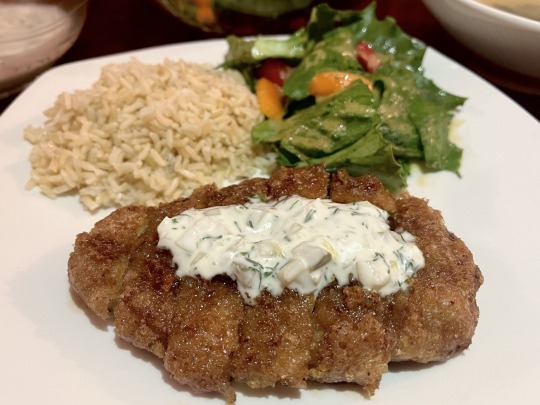
[ID: A fried 'chicken' cutlet topped with tartar sauce and served with rice and a green salad; bowls of tartar sauce and miso soup are in the background. End ID]
チキン南蛮 / Chicken nanban (Japanese fried chicken with sweet-savory sauce)
Chicken “nanban” (南蛮; "barbarian" or "foreign") is a classic example of 洋食 (yoshoku)—Western-style food adapted to a Japanese palette. Chicken breast is breaded, deep-fried, and coated in a mixture of soy sauce, sugar, and vinegar to create a crispy, tangy, savoury-sweet dish.
The method of breading and deep-frying used in making chicken nanban, tempura, and other Japanese dishes was introduced by the Portuguese during the Muromachi period (16th century). Chicken nanban itself, however, is far more recent: Nao-chan diner in the Miyazaki Prefecture of Kyushu is credited with having invented it in the 1950s. Nao-chan's version of the dish does not include tartar sauce, but it is often added to provide a sharp, creamy complement to the savoury chicken.
Chicken nanban works well as a main dish served with sides of rice, soup, or salad. If you're using pre-made chicken breasts, it comes together in around half an hour.
Recipe under the cut!
Patreon | Tip jar
Serves 4.
Ingredients:
For the chicken:
4 Gardein chicken breasts, or other chicken breast substitute, thawed
1/4 cup (30g) all-purpose flour
2 Tbsp potato starch or cornstarch (optional)
2 Tbsp egg replacer (I used Bob's Red Mill)
Water
Pinch kosher salt
A few cracks of black pepper
Oil to deep fry
For the nanbanzu / 南蛮酢 (nanban sauce):
3 Tbsp Japanese soy sauce, such as Kikkoman's
3 Tbsp rice vinegar
3 Tbsp granulated vegetarian sugar
1 1/2 Tbsp mirin (for a low-alcohol version, use aji-mirin; for an alcohol-free version, replace with 1/2 Tbsp rice vinegar and 1 Tbsp sugar)
For the tartar sauce:
1/2 cup vegan mayonnaise
1/2 tsp mild Dijon mustard
2 tsp rice vinegar
1 tsp dried ground shiitake mushroom, or kombu dashi powder
1 tsp vegetarian sugar
A few small sweet pickles or 1 Japanese or Persian cucumber, diced
1/2 small yellow onion, minced
Pinch kosher salt
Pinch of MSG
Minced dill or parsley (optional)
If you eat eggs, you can replace the first five ingredients with 1/2 cup Kewpie mayo (キューピーマヨ).
Instructions:
For the nanbanzu / 南蛮酢 (nanban sauce):
1. Heat sugar and soy sauce in a small pot over medium-low heat until simmering, stirring to dissolve.
2. Add vinegar and mirin and heat for another 30 seconds. Remove from heat.
For the tartar sauce:
1. Mince the onion. If you prefer, you can submerge the minced onion in cool water for 10 minutes or so and then drain to remove some of its sharpness. Seed and mince the cucumber.
2. Whisk mayonnaise, mustard, sugar, salt, black pepper, MSG, rice vinegar, and mushroom powder together to combine. Add onion and cucumber and stir. Top with herbs. Refrigerate while preparing the chicken.
For the chicken:
1. Mix flour, starch, salt, and black pepper together on a plate or cutting board. In a small bowl, combine egg replacer with water according to package directions and allow to thicken.
2. Fill a deep fryer or medium-sized pot with several inches of a neutral oil and heat it to 340 °F (171 °C). A chopstick placed in the oil should slowly form small bubbles around its tip.
3. Coat chicken breasts with egg replacer; if it is too thick, you may need to whisk in an additional 1-2 Tbsp water.
4. First deep fry. Carefully lower one chicken breast into the oil and fry without disturbing for about 2 minutes, until the egg coating on the bottom side is cooked through and lightly golden brown. Flip over and continue to fry for another 2 minutes. Use chopsticks or a slotted spatula to remove the chicken breast onto a wire cooling rack or paper-towel-lined plate.
5. Use a slotted spoon to remove any bits of batter from the oil and re-check the temperature. Repeat with each chicken breast.
6. Second deep fry. Increase the heat slightly to raise the temperature of the oil to 355 °F (179 °C). Re-fry each chicken breast for about a minute, flipping once halfway through. Set aside.
7. Coat with nanban sauce. Place the fried chicken breasts in a shallow rimmed baking dish or tray and spoon most of the nanban sauce over them, turning over several times to coat. Reserve the rest of the sauce for serving.
8. Slice each chicken breast widthwise and transfer to an individual serving plate. Serve with additional nanban sauce, tartar sauce, rice, a green salad, or soup.

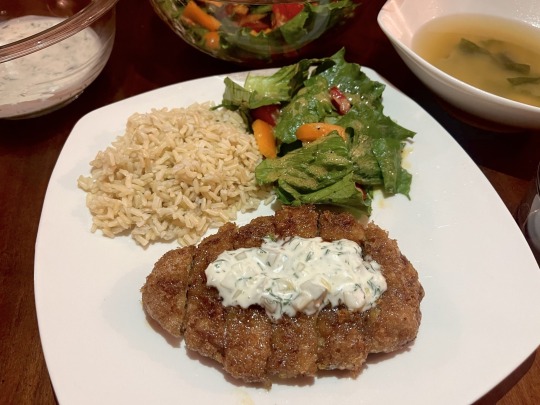
104 notes
·
View notes
Photo
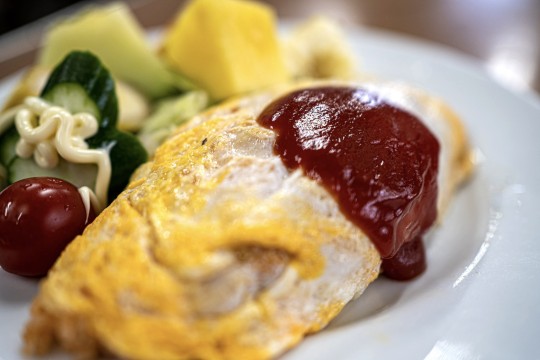
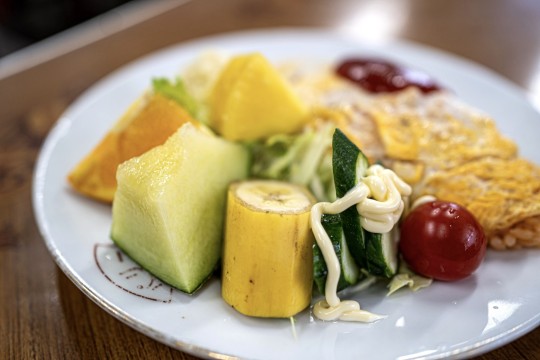
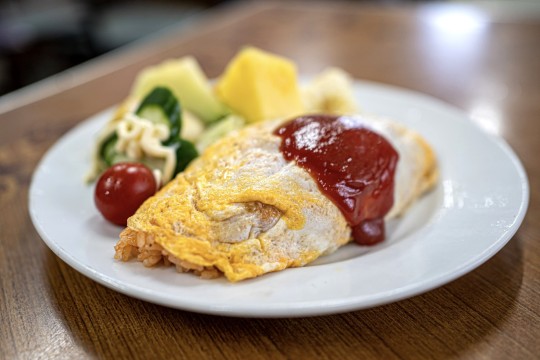


絶メシロードに登場!埼玉・秩父の昭和2年創業のレトロな食堂で「オムライス」を | パリー食堂(埼玉県秩父市)
(via 絶メシロードに登場!埼玉・秩父の昭和2年創業のレトロな食堂で「オムライス」を - ニッポンごはん旅)
15 notes
·
View notes
Text
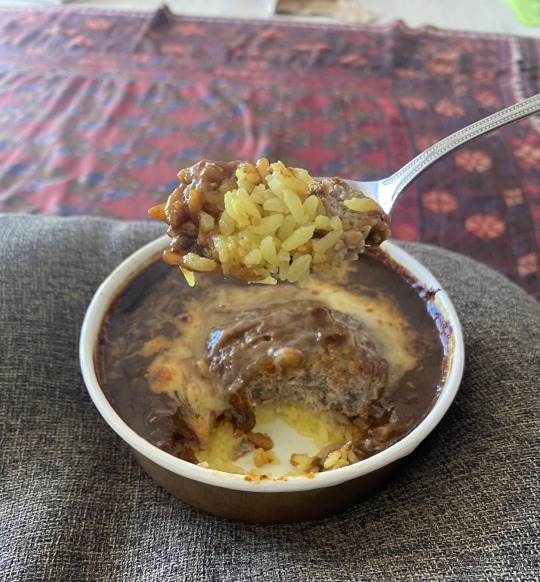
Beef hamburg curry doria from 7-11! Not something that would normally tempt me, but my husband got one and it smelled so good that I jumped at my next chance.
Apparently it's made under the supervision of the Indian restaurant Ginza Delhi, but the curry is pretty solidly in the Japanese category. For me, the curry-cheese combo can be hit or miss, but this time it worked beautifully, especially if it's cold and you're craving something hearty.
#(doria = basically a gratin made with rice#invented by a swiss chef in japan in the 30s)#conbini#doria#yoshoku
20 notes
·
View notes
Text





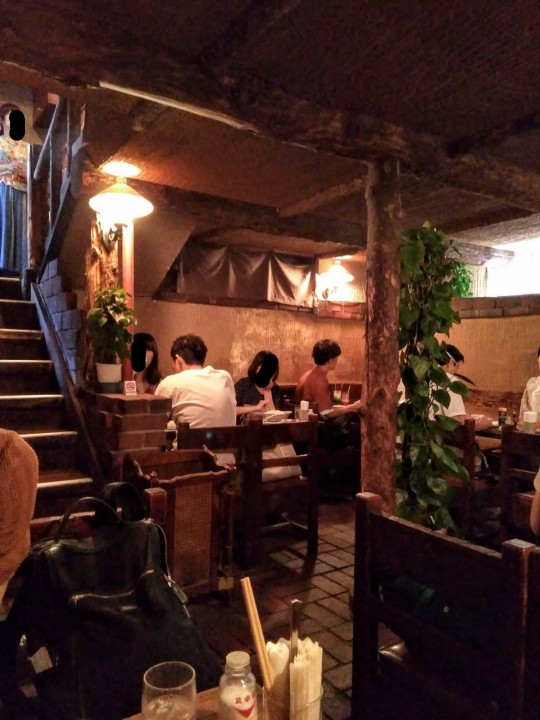
さぼうる (Sabouru)
Jinbocho, Chiyoda-ku, Tokyo (October 5th, 2019)
#kissa#kissaten#retro kissa#junkissa#喫茶#レトロ喫茶#喫茶店#純喫茶#jinbocho#chiyoda#japan cafe#retro japan#old cafe#showa retro#cafe aesthetic#yoshoku
14 notes
·
View notes
Text

I made menchikatsu!!
3 notes
·
View notes
Text
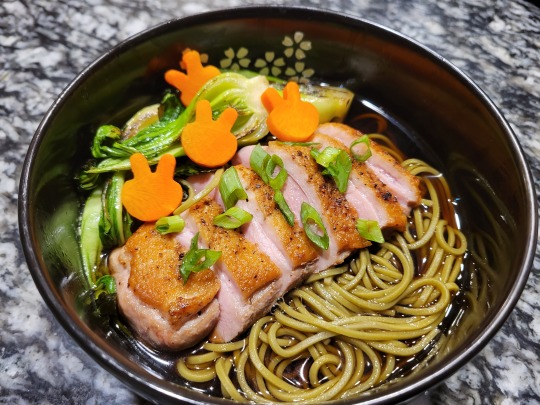

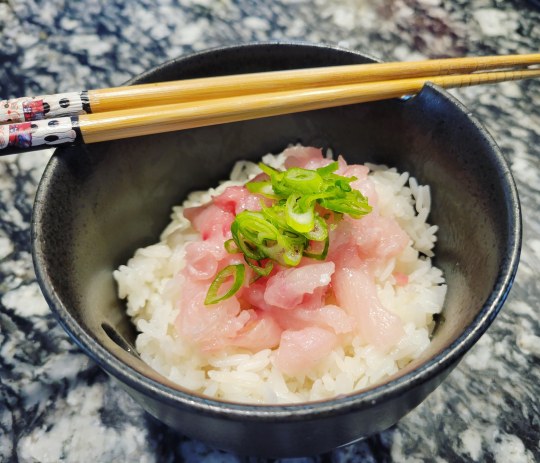

Just perpetually making food and avoiding real hobbies
13 notes
·
View notes
Text
Ideas for Gravity Falls-Themed Yoshoku Dishes Idea.
Dipper
Chicken Torikatsu with shoyu-syrup-lime juice based sauce
Brief Description: Chicken Cutlet that is double-fried lightly, inspired from Korean Method. Topped on rice with light sauce mainly composed of shoyu light syrup, and lime juice with some aromatic herbs. Sided with Salad
Mabel
Varieties of Decorative Tempuras and Shaped Korokke
Brief Description: Shrimp and Vegetable Tempura decorated in edible glitter of gold and silver, along with Korokke shaped into mythical creatures, shooting star, sweater, and so-on. Served with confetti and “Mabel’s Fortune Sembe”
Wendy
Steak with miso-Momotaro Tomato Puree sauce
Brief Description: Meat of choice that you can choose the cut, and doneness(if it is beef). Marinated with miso-based sauce, before topped with tomato-shoyu thick sauce. Served with potato salad.
Stanley
Fish Hambagu
Brief Description: Fish-based Hambaku patty, filled with cubed squid and shrimps. Served with dollar-decorated seaweed sheets over bowl of rice. Topped with Nanban Cream Sauce, or Sour Salad Dressing as choice.
Ford
Napolitan Pasta with including of Tantantem seasonings
Brief Description: Napolitan Pasta based on Italian version, but drier, more garlicky and spicy. Plus, Tantanmen Seasonings’ peppers is based on Sichuan & Korean ingredients.
Soos
Okonomiyaki with umami bomb
Brief Description: Kansai-Style Okonomiyaki packed with mushroom, dried seaweed, grilled meat stripes, seafood broth, and herbal blends.Topped with “?” mayo, as well as bottles of various sauce to flavor it your way.
Pacifica
Spicy Spam Curry Doria
Brief Description: Underneath varieties of oozy cheesy blend, lay the curry with extra spicy twist, cubed spam, and chopped vegetables. It’s sided with either baked loaf of bread and butter, or Japanese rice.
McGucket
Creamy Natto Spaghetti
Brief Description: Sound unlikely, but instead of taming Natto, it is adapting Natto in Carbonara Spaghetti. Raw egg also topped on it, as well as some spring onion, and mustard on side.
Gideon
Themed Bento of his vibe
Brief Description: Six onigiris with different tastes united as star-shaped, amulet-shaped wakame pile, and fried rice with egg decorrelated into his face. Served with Sashimi, shoyu, and wasabi.
Robbie
Cream Stew blackened with seaweed and squid ink
Brief Description: Creamy stew with rice on the side, but both is blackened. Stew is with ink and seaweed extract, making it dark and umami, going with with seafood and parmesan. While the unprocessed rice is mixed with five legumes and other grains.
Bill
Omurice-Onigiri Fusion
Brief Description: Onigiris with tamago sheet on the outer layers, which having 6 of them. Each 6 of them focus on different flavor; sweet, sour, savory, bitter, salty, and pungent. In addition, there are 6 mini-side dishes, and six furikake to coat the remained rice with.
#gravity falls#gf idea#themed restaurant#Disney Channel#yoshoku#gravity falls idea#zodiac gravity falls#gf zodiac#bill cipher
2 notes
·
View notes
Text
Cult Sando
Book review:
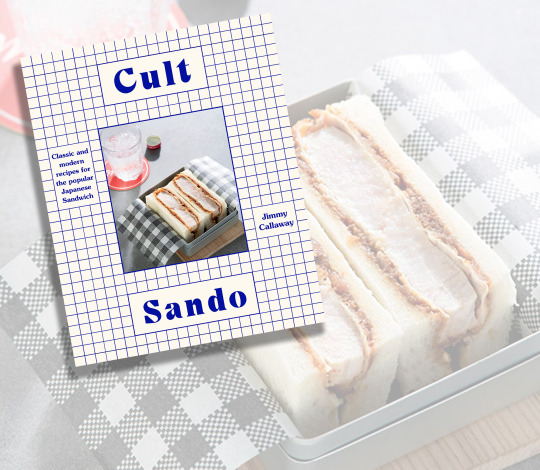
Sando, the evolved form of the sandwich, is an iconic Japanese food. Crustless, thick milk bread firmly pressed around a diverse range of possible fillings. Optimised for maximum photogenic cross cut and immaculately packaged, they sit in konbini and vending machines everywhere. Cult Sando is a recipe book by Australian pro foodie Jimmy Callaway. Tastefully presented in both senses of the word.
According to the book, the origin of the sando can be traced to a bread boom in Japan in the 70s. The origin of milk bread is slightly less clear cut. Bread historians vary on what qualifies and when the accepted form arose. Also referred to as shokupan, this faintly moist, fluffy bread is sliced thick and crustless in all recipes. In something of a reflected takeover, the Japanese sandwich, and its vital milk bread are both increasingly appearing outside of Japan.
An early footnote explains about the difference between US, UK tablespoons and Australian tablespoons. This telling localisation reflective of the intended readership. Jimmy Callaway is an indeed an antipodian. He comfortably drops various Sydney references in interviews and an early book signing was held at Balmain's Roaring Stories bookstore. He was formerly chef at Firedoor restaurant. Cult Sando is his debut book.
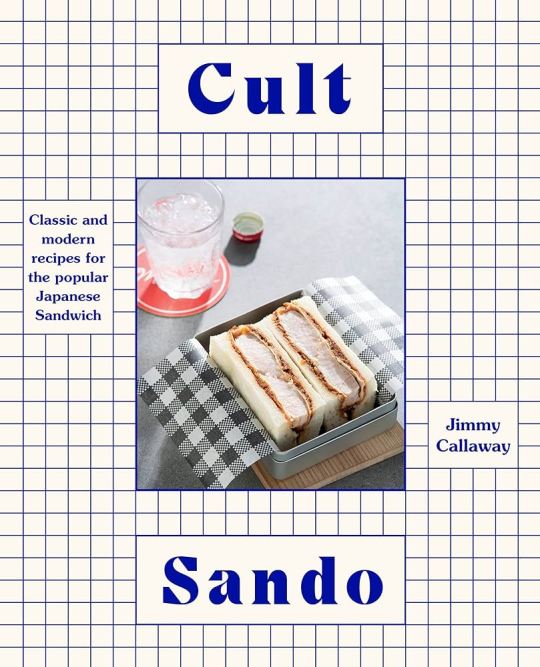
Shelf: 596.63 CAL
Cult sando : classic and modern recipes for the popular Japanese sandwich
by Jimmy Callaway ; photographer Alan Benson.
Sydney, N.S.W. Harper by Design 2022
ISBN: 9781460762554
111 pages : colour illustrations ; 22 cm. "Includes index (pages 106-108).
Text in English.
#review#cook book#cookbook#callaway jimmy#food#recipes#sandwich#sando#japanese cuisine#yoshoku#shokupan#milk bread#new 2024 04#review 2024 04#jcentral
1 note
·
View note
Photo

Lots on the go these days...here's a quick pasta dish: spaghetti tossed in cream, chilli crisp, baby spinach. Optional, a splash of hot sauce for extra kick. #asian #western #spaghetti #vegetarian #yoshoku #fast #quick (at Agincourt) https://www.instagram.com/p/CkbW3oyOFnD/?igshid=NGJjMDIxMWI=
0 notes
Text
My biggest secret is I don't even like japanese food that much as food and not as a hobby... like I like it, the way I like almost every kind of well prapred cuisine, even ashkenazi lol. I enjoy all sorts of food and some Japanese foods I'm really fond of (I'm a sucker for natto). But it's just not my cup of tea, like i don't think i experience as great a joy as when i eat proper japnese food but flavor wise? Not compareable to like how i drool at some other cuisines. I'm Middle Eastern, if not for my weird Japanese food hobby I don't see a way in which I'd have ever preferred it over most chinese, thai or Korean, even more so Indian, defiantly not over Mexican (which I know less about, so from approx.) And of course wayyy after my home cuisines. Even italian since it's mediterranean❣️ I'd say a good japanese meal is on par with a good French meal, not my palate, but it can be very, very good and enjoyable.
Like I can't help but remember every time I'm proud of making a fully authentic and precise japanese meal as i sit down to eat it that japanese saying about how the West got the smell (included india as west, so spices) china has the flavor and japan the aesthetics... like yeah...
#not inc. chuka & yoshoku ig but also kinda compared to their home versions often#and trust me i really appriciate it for what it is i really go crazy for japanese food and jts beauty and techniques and food#everyone that knows me knows that like id eat japanese food sometimes like all day everyday for months lol#im really passionate about it but its just a crazy hobby like i need my MENA spices and tomatoes and lemon pleaseeee
4 notes
·
View notes
Text
i mean you can shit on "white people bs" all you want i suppose but having to eat your own words as soon as non white people decide to take elements of european/american culture and make a facsimile of it within their own framework (lolita fashion, yoshoku, any and all americana aesthetics co-opted by kpop etc) will never not be funny to a non white bystander like myself bc then you either have to accept that erecting strict borders around "white people shit" and "not white people shit" is some cop behavior or you will have to inevitably follow the thread down into depths you are neither prepared nor qualified to delve into
#rambles#like there is a whole Thing to be made of white supremacy and vague white exoticization manifesting in these bastardized westernisms#but are you‚ a middle income undergrad from wyoming‚ ready to talk about it without your asscrack showing?
33 notes
·
View notes
Text
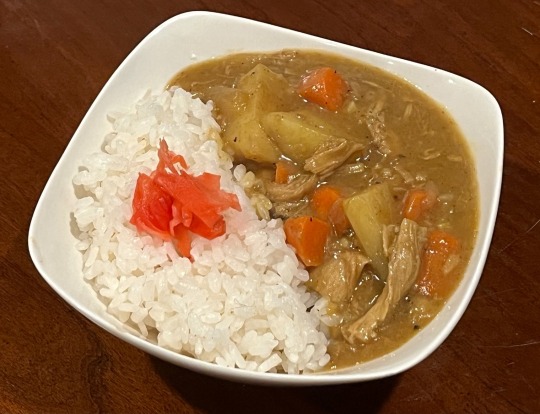
[ID: A bowl with short-grained rice to the left and a curry to the right; a spoonful of pickled ginger tops the rice. End ID]
カレーライス / Kare raisu (Japanese "curry rice" with carrot and potato)
Kare raisu is a classic example of 洋食 (yoshoku)—Western-style food adapted to a Japanese palette. It first became popular among the Japanese navy, having been inspired by the diet of the British navy in the late Meiji period—the British themselves had appropriated and adapted dishes which they termed “curries” during their imperial rule of India.
The base of kare raisu's flavor profile is カレー粉 (kare ko, curry powder), which is used to spice the roux that thickens the curry. Since they were first manufactured and sold in the 1950s, premade curry roux cubes have been popular among home cooks as a quick way to season this dish. This recipe begins by making enough roux for the dish, for those without Japanese curry roux cubes at home.
Kare raisu is often made with chicken or pork belly, but meat is sometimes omitted. This recipe calls for sườn non chay, but if you don’t want to use a meat replacement, just increase the amount of carrot and potato!
Recipe under the cut.
Patreon | Tip jar
This recipe calls for you to make a roux as its base, as this is the most widely-used technique for this dish. A similar effect could be achieved by adding Japanese curry powder in after the onions are browned and proceeding with the dish from there, adding butter or margarine along with the water, and thickening the curry with some flour after the vegetables are tender, if desired.
Ingredients:
For the chicken:
1 package (100g) sườn non chay, or 350g other vegetarian meat substitute
(If using sườn non chay) several cups vegetarian ‘chicken’ or ‘beef’ stock from concentrate, vegetable stock, or water
1/4 tsp Japanese curry powder
A few cracks of black pepper
For the dish:
2 Yukon gold potatoes (400g), peeled
2-3 medium carrots (200g)
1 package (100g) suon non chay, or 350g other vegetarian chicken substitute
6 cups water, or enough to cover
2 tsp vegetarian ‘chicken’ or ‘beef’ stock concentrate (optional)
3 Tbsp neutral oil, to fry
2 large yellow onions, sliced
1/2 sweet apple, grated (optional)
3 Tbsp usata sosu (Japanese Worcestershire-style sauce)
1 Tbsp vegetarian oyster sauce (or substitute soy sauce)
1/4 cup coconut milk (optional)
4 cloves garlic, minced
1-inch chunk (10g) ginger, minced
Sườn non chay may be found in bags online or at your local Asian grocery–the bags will be labelled “sườn non chay” as well as “vegan meat slice,” “textured soy bean protein,” “vegetarian food,” or “vegan food.”
Apple is a fairly common but non-essential addition to this curry; it adds a subtle sweetness to the final dish without being immediately recognizable as apple. Other common additions which have the same effect are honey, jam, and mashed banana.
The Japanese Worcestershire sauce adds umami, salt, sweetness, and a hint of fruit: it may be replaced with equal parts soy sauce, ketchup, molasses, and date syrup or apple sauce.
The coconut milk adds savor and a creamy texture; the flavor of coconut is not detectable in the final dish. You could also use soy or oat milk for this purpose.
For the roux:
3 Tbsp Japanese curry powder
1/4 cup non-dairy margarine
6 Tbsp (45g) AP flour
Instructions:
For the roux:
1. Melt margarine in a small pot on medium, then reduce heat to medium-low. Add flour and toast for 15-25 minutes, stirring occasionally, until flour is lightly golden brown.
2. Add curry powder and toast for 30 seconds, until fragrant. Remove from heat.
For the dish:
1. If using sườn non chay: In a stockpot, soak sườn non chay in enough stock to cover for about an hour, until rehydrated. I also added a few cracks of black pepper and about 1/4 tsp of Japanese curry powder to the stock.
Adding a small plate to keep the sườn non chay beneath the surface of the liquid can help them to soak faster.
2. Tear sườn non chay into thin strips and return to the pot. Simmer, stirring occasionally, until the liquid has evaporated; set aside.
Soaking in broth or stock helps the flavor of the sườn non chay to be more concentrated. If you're short on time, just soak them in water until softened, squeeze the excess water out, tear them into strips, and set aside until ready to fry.
3. Prepare your vegetables. Peel potatoes and cut into wedges (if your potatoes are particularly large, halve them widthwise first). Peel the carrots and chop them with diagonal cuts, rotating the carrot about 1/4 turn between each cut (this style of cutting—rangiri—is commonly used when preparing cylindrical vegetables for simmering in stews, because it increases their surface area). Halve the onions through the root and then cut them into slices; mince the garlic and ginger.
Some cooks will cut the onions into wedges and fry them until translucent, while others cut them into thin slices and fry until they are deeply golden brown; I took the latter route to add savor to the final dish, but consult your own preferences (and time!).
4. Heat 3 Tbsp neutral oil in a large stockpot (the one you simmered the sườn non chay in, wiped clean, is fine). Fry sườn non chay until lightly browned and set aside. (If using a different meat replacement, follow the package directions for stovetop frying.)
5. In the same pot, fry onion on medium-low for 20-30 minutes until golden brown, agitating occasionally. Add ginger and about half the garlic and fry for 30 seconds until fragrant. I like to add about 1/4 of the roux at this point and fry until fragrant to increase the presence of the spice in the final dish, but this isn't common in Japanese preparations.
6. Add carrots and potato and allow to fry for about 2 minutes. Add apple and stir to combine.
7. Whisk water together with stock concentrate, Worcestershire sauce, and oyster sauce, and add to the pot. Return your meat replacement to the pot.
8. Simmer, covered, for about 15 minutes, until carrots and potatoes are fork-tender.
9. Dissolve the rest of the curry roux into the sauce and add the remainder of the garlic (this divided addition allows for a sharper garlic taste). Add coconut milk, if desired. Simmer, uncovered, until thickened, about 5 minutes. Taste and adjust sauces.
Serve warm with short-grained rice and fukujinzuke or rakkyozuke.
#Japanese#recipe#vegan recipes#vegan cooking#vegetarian recipes#yoshoku#carrots#potatoes#suon non chay#sườn non chay#apple#coconut milk#osata sosu#kare ko
107 notes
·
View notes
Photo
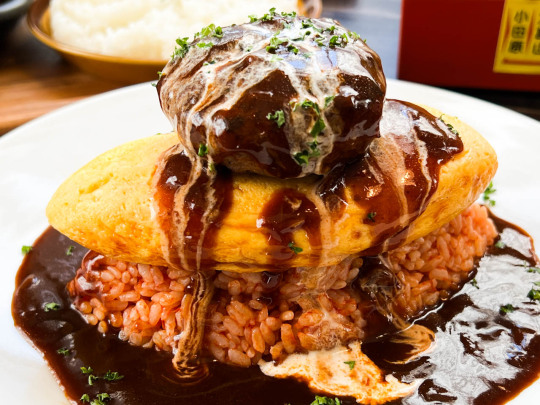


「三浦赤たまごと足柄牛ハンバーグ 贅沢オムバーグ」- 大雄山線 駅舎カフェ1の1, 小田原 (source)
(via 小田原にレトロな駅舎カフェがオープン!ハンバーグやスイーツも映えるメニューがそろう「大雄山線 駅舎カフェ1の1」実食ルポ - 記事詳細|Infoseekニュース)
13 notes
·
View notes
Text
@ryutarotakedown asked me for my Susato hcs for the ask game!
Realistic: She eats small bites out of politeness but has a taste for yoshoku food! She loves curry rice, croquettes, and all sorts of sweets! She also really likes the novella Carmilla by Sheridan Le Fanu and The Strange Case of Dr Jekyll and Mr Hyde for more reasons than she can admit to herself!
Unrealistic, but funny: She is an Excellent gambler and has snuck into horse races and won. A lot. Unfortunately, 221B is a biiiit of a money sink so her winnings often go up in smoke.
Angsty: She alternately loves and despises her Ryuutarou identity, and he is basically the Edward Hyde to her Henry Jekyll. She has nightmares about him breaking her ribcage open and crawling out because she is so deeply repressed about many things, like her dissatisfaction with societal misogyny's impeding of her ambitions, her lesbianism, her gender, her grief...many problems she crushes inside of her and refuses to address. Whether she likes or not, they will come out eventually in some way.
Canon can eat my shit and hair: She is not fucking skinny wtf are you on Capcom put some meat on that poor girl's bones!!! She needs muscles to toss grown men!!! Also she will marry Haori as Ryuutarou Naruhodou and no one can change my mind on this.
11 notes
·
View notes
Note
Is Jubilife food a mix between foreign recipes and the local cuisine? Something like Yoshoku?
The food in jubilife would be an absolute melting pot of cultures and cuisines. You have people from Galar and Alola and Kalos and Hoenn and Johto and Kanto, basically everywhere!
Asian cuisine would be more common, mostly because of the majority of people are from Kanto/Johto/Hoenn, which are all based off other areas in Japan, and influence from the locals.
Laventon has a cheese stash though.
59 notes
·
View notes
Note
As a Italian, what are your thoughts on the Japanese spaghetti dish Napotalitan? The way I've learnt it is it you boil the spaghetti, halfway throw in frozen vegetables like carrot, corn, and peas. Then you cut mushrooms, garlic, and hotdog/sausage into pieces. Add butter to a frying pan, saute the mushrooms first, then the hotdog pieces, then the garlic. After pouring out the water, add the spaghetti and vegetables into the frying pan and add some extra butter. Sauté for a while, then.... Add ketchup as your wok sauce or so to say. Add enough ketchup while woking so your spaghetti turns a reddish orange color and you can taste it (it tastes really different when fried like that), and it's done. I make it sometimes as it's simple, relatively healthy, and personally find it really good.
Some Americans to be "accepting" call it a "fried noodles" dish as "Japanese people cannot possibly like spaghetti, because Japanese people only eat noodles"... Some people 🙄...
Yoshoku is what they're called, western inspired Japanese dishes. I don't think there are any inspired by my country and like those I've tried, but I don't know how it'd feel if there were. But some Americans pretending that it isn't a thing isn't the answer...
screamed in terror when i read hotdog and ketchup, but as far as i know ketchup is used in many japanese dishes
honestly i'd put sausage or bacon and tomato sauce (pretty much like naples sauce, that's made with sausage, beef, ribs and tomato), but overall doesn't sound half bad -- especially because its interesting to see a western dish made like a japanese one. i personally westernized omurice once and it came out pretty good, so it's fun to see the opposite happen too!!
and lets be real i don't think americans can tell anyone what is and isn't supposed to be a pasta dish
10 notes
·
View notes